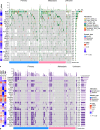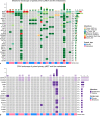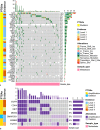Molecular and Functional Heterogeneity of Primary Pancreatic Neuroendocrine Tumors and Metastases
- PMID: 37232011
- PMCID: PMC10614458
- DOI: 10.1159/000530968
Molecular and Functional Heterogeneity of Primary Pancreatic Neuroendocrine Tumors and Metastases
Abstract
Introduction: Treatment response to the standard therapy is low for metastatic pancreatic neuroendocrine tumors (PanNETs) mainly due to the tumor heterogeneity. We investigated the heterogeneity between primary PanNETs and metastases to improve the precise treatment.
Methods: The genomic and transcriptomic data of PanNETs were retrieved from the Genomics, Evidence, Neoplasia, Information, Exchange (GENIE), and Gene Expression Omnibus (GEO) database, respectively. Potential prognostic effects of gene mutations enriched in metastases were investigated. Gene set enrichment analysis was performed to investigate the functional difference. Oncology Knowledge Base was interrogated for identifying the targetable gene alterations.
Results: Twenty-one genes had significantly higher mutation rates in metastases which included TP53 (10.3% vs. 16.9%, p = 0.035) and KRAS (3.7% vs. 9.1%, p = 0.016). Signaling pathways related to cell proliferation and metabolism were enriched in metastases, whereas epithelial-mesenchymal transition (EMT) and TGF-β signaling were enriched in primaries. Gene mutations were highly enriched in metastases that had significant unfavorable prognostic effects included mutation of TP53 (p < 0.001), KRAS (p = 0.001), ATM (p = 0.032), KMT2D (p = 0.001), RB1 (p < 0.001), and FAT1 (p < 0.001). Targetable alterations enriched in metastases included mutation of TSC2 (15.5%), ARID1A (9.7%), KRAS (9.1%), PTEN (8.7%), ATM (6.4%), amplification of EGFR (6.0%), MET (5.5%), CDK4 (5.5%), MDM2 (5.0%), and deletion of SMARCB1 (5.0%).
Conclusion: Metastases exhibited a certain extent of genomic and transcriptomic diversity from primary PanNETs. TP53 and KRAS mutation in primary samples might associate with metastasis and contribute to a poorer prognosis. A high fraction of novel targetable alterations enriched in metastases deserves to be validated in advanced PanNETs.
Keywords: Genetics; Metastasis; Molecular heterogeneity; Pancreatic neuroendocrine tumors; Targeted therapy.
© 2023 The Author(s). Published by S. Karger AG, Basel.
Conflict of interest statement
The authors have no conflicts of interest to declare.
Figures






Similar articles
-
Loss of Chromatin-Remodeling Proteins and/or CDKN2A Associates With Metastasis of Pancreatic Neuroendocrine Tumors and Reduced Patient Survival Times.Gastroenterology. 2018 Jun;154(8):2060-2063.e8. doi: 10.1053/j.gastro.2018.02.026. Epub 2018 Mar 2. Gastroenterology. 2018. PMID: 29486199 Free PMC article.
-
Evolutionary Trajectories of Primary and Metastatic Pancreatic Neuroendocrine Tumors Based on Genomic Variations.Genes (Basel). 2022 Sep 4;13(9):1588. doi: 10.3390/genes13091588. Genes (Basel). 2022. PMID: 36140756 Free PMC article.
-
Comparison of neuroendocrine differentiation and KRAS/NRAS/BRAF/PIK3CA/TP53 mutation status in primary and metastatic colorectal cancer.Int J Clin Exp Pathol. 2014 Aug 15;7(9):5927-39. eCollection 2014. Int J Clin Exp Pathol. 2014. PMID: 25337237 Free PMC article.
-
Integrated Genomic and Clinicopathologic Approach Distinguishes Pancreatic Grade 3 Neuroendocrine Tumor From Neuroendocrine Carcinoma and Identifies a Subset With Molecular Overlap.Mod Pathol. 2023 Mar;36(3):100065. doi: 10.1016/j.modpat.2022.100065. Epub 2023 Jan 10. Mod Pathol. 2023. PMID: 36788102 Review.
-
Genetics of pancreatic neuroendocrine tumors: implications for the clinic.Expert Rev Gastroenterol Hepatol. 2015;9(11):1407-19. doi: 10.1586/17474124.2015.1092383. Epub 2015 Sep 28. Expert Rev Gastroenterol Hepatol. 2015. PMID: 26413978 Free PMC article. Review.
Cited by
-
Gastroenteropancreatic neuroendocrine neoplasms: epidemiology, genetics, and treatment.Front Endocrinol (Lausanne). 2024 Sep 30;15:1424839. doi: 10.3389/fendo.2024.1424839. eCollection 2024. Front Endocrinol (Lausanne). 2024. PMID: 39411312 Free PMC article. Review.
-
Transcriptomic profiling of pancreatic neuroendocrine tumors: dysregulation of WNT, MAPK, PI3K, neddylation pathways and potential non-invasive biomarkers.PLoS One. 2025 Jun 16;20(6):e0325672. doi: 10.1371/journal.pone.0325672. eCollection 2025. PLoS One. 2025. PMID: 40522948 Free PMC article.
-
Prolonged Low-Dose Administration of FDA-Approved Drugs for Non-Cancer Conditions: A Review of Potential Targets in Cancer Cells.Int J Mol Sci. 2025 Mar 18;26(6):2720. doi: 10.3390/ijms26062720. Int J Mol Sci. 2025. PMID: 40141362 Free PMC article. Review.
-
Opposing Effects of Cannabidiol in Patient-derived Neuroendocrine Tumor, Pheochromocytoma/Paraganglioma Primary Cultures.J Clin Endocrinol Metab. 2024 Oct 15;109(11):2892-2904. doi: 10.1210/clinem/dgae241. J Clin Endocrinol Metab. 2024. PMID: 38605427 Free PMC article.
-
Management of patients with small pancreatic neuroendocrine tumors from a biomarker and surgical perspective.Endocr Relat Cancer. 2025 Apr 4;32(5):e240305. doi: 10.1530/ERC-24-0305. Print 2025 May 1. Endocr Relat Cancer. 2025. PMID: 40117346 Review.
References
-
- Rindi G, Klimstra DS, Abedi-Ardekani B, Asa SL, Bosman FT, Brambilla E, et al. . A common classification framework for neuroendocrine neoplasms: an International Agency for Research on Cancer (IARC) and World Health Organization (WHO) expert consensus proposal. Mod Pathol. 2018 Dec;31(12):1770–86. 10.1038/s41379-018-0110-y. - DOI - PMC - PubMed
Publication types
MeSH terms
Substances
LinkOut - more resources
Full Text Sources
Medical
Research Materials
Miscellaneous

